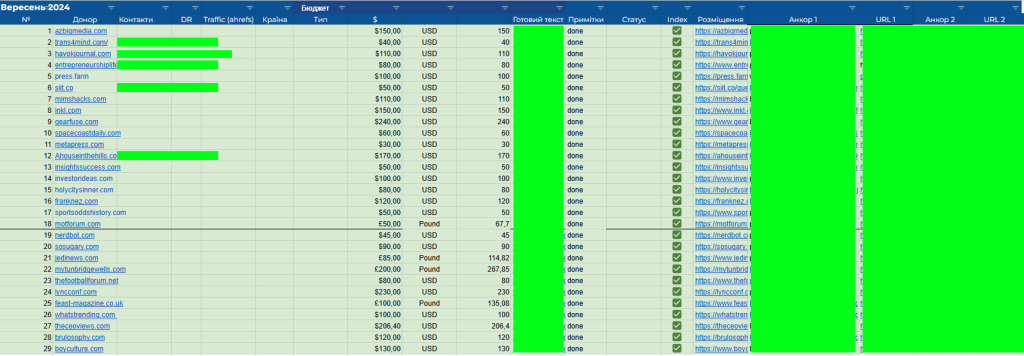Investing in SEO for arbitrage teams: How to earn $150K in a year

Introduction
The unique challenge faced by an arbitrage team striving to reach a new level of traffic monetization became an intriguing case for us—one we’re excited to share.
A client approached us with an unusual request—an arbitrage team looking to diversify its traffic acquisition channels and reach the top of search engine rankings to generate a return on investment. Their key challenge was the inability to stay in one GEO (geographical targeting, region) for too long. What made this project particularly interesting was the client’s solid analytical foundation: the team already had data on GEOs and key queries that demonstrated the highest conversion rates for them. Their strategy revolved around building a network of websites capable of generating organic traffic from multiple countries.
However, their ultimate goal was different—to invest their funds in SEO traffic for selected keywords and GEOs, with the intention of reselling it later and achieving at least double the profit within a year. We decided to take on this challenge. Our task was to develop an effective SEO strategy that would allow for rapid and efficient scaling of the project while ensuring investments were directed toward the right and most profitable regions.
The SEO promotion market for arbitrage teams has its own unique characteristics. Unlike our traditional client-oriented approaches, the key performance indicators (KPIs) here were not just traffic but also the speed of reaching the top search rankings and the potential for monetization. The client understood that classic SEO methods wouldn’t work in this case, so they were looking for an unconventional approach that would allow them to invest profitably.
The uniqueness of this project lay in the need for rapid scaling. The arbitrage team required not just SEO promotion but a full-fledged investment strategy that would turn our SEO efforts into a stable revenue stream for them. We understood that we weren’t just creating and optimizing websites—we were building investment tools with the potential for a fast ascent to the top of search results within the shortest possible timeframe and within a set budget (the client had $50K to invest).
Research and strategy development
Before starting, we conducted a comprehensive SEO analysis of the niche across different regions and keywords. The analysis revealed that the level of competition varied significantly depending on the country. One particularly interesting finding was that our target query exhibited an unusual trend—websites without any backlink profiles were leading the search results, even outperforming resources with a Domain Rating (DR) of 96.
Domain Rating is a metric that reflects the strength of a website’s backlink profile on a scale from 0 to 100. The higher the DR, the more authoritative the site appears to Google. This unexpected ranking trend raised some important questions.

This complicated traditional competitor analysis and required an unconventional approach to completing tasks. The top rankings were dominated by unknown websites with low DR and no significant number of backlinks. Some had a multilingual structure with subfolders, while others used separate regional domains.
These observations from our initial analysis became the key to shaping our future strategy. We developed a new promotion tactic for arbitration teams, aimed at increasing profitability and making the right investments.
During our research, we also discovered an interesting content protection method used by many competitors. Some websites were configured in a way that prevented direct access via a direct link. The only way to access such a site was through Google search results.
This demonstrated a high level of ingenuity among competitors in the arbitration environment. Website owners had created a complex system to protect their content, tactics, and strategies from rivals.
Based on our preliminary analysis, we drew the following conclusions about competitors:
- The top rankings were dominated by unknown websites with low DR and no significant number of backlinks.
- Some websites had a multilingual structure with subfolders, while others used separate regional domains.
- Certain sites blocked direct access, allowing users to reach the page only through Google search results.
To build our strategy, we needed to test all the hypotheses we had formulated during the environmental analysis. Based on the collected data, we considered two options:
- Creating separate regional websites with corresponding domains.
- Developing a large multilingual website with subfolders for different language versions.
Instead of making massive one-time investments, we decided to create a network of test sites. This approach allowed us to minimize risks and quickly identify the most effective promotion model. We also decided to create Exact Match Domain (EMD) sites tailored to specific slots. In SEO, this means incorporating the target keyword into the website’s name, i.e., the domain. Since the client knew their strong keywords, this became our advantage moving forward.
Project Kickoff
Development
The first step was creating fifteen test sites for different geographic regions: Spain, Belgium, Ireland, Germany, and several other countries. Each site had unique characteristics, including different visual designs, custom layouts, and differentiated title structures (title, description, H1-H2). However, each site included an exact match of the target keyword in the domain. At the same time, we developed another multilingual website on a domain using subfolders for different language versions.
Link Building
The technical implementation involved multiple stages of link building. Initially, we used budget-friendly methods such as crowd marketing and automated link runs. This allowed us to quickly assess the potential of each site while keeping costs low. After identifying the sites with the highest growth dynamics, we moved on to more aggressive and costly methods—ranging from white-hat outreach and purchasing high-quality links on authoritative resources to “baking” SEO pies.

Content Strategy
Special attention was given to the content strategy. Each website was optimized for specific key queries, considering the peculiarities of the local search environment. We created unique content that not only met the technical requirements of search engine optimization but also had high relevance for the target audience.
Semantic Work
However, not all victories came on the first try. Initially, we followed a classic approach, working with both high-frequency (HF) and medium-frequency (MF) keywords from the client’s table. Over time, it became evident that MF queries did not yield significant financial results. We were spending resources but not seeing corresponding profit growth. Only midway through the project did we realize that the real value lay in HF queries.
As soon as we focused exclusively on high-frequency keywords, everything changed. Within a month, we achieved a TOP-1 ranking for the most competitive queries in multiple GEOs, bringing tangible financial results for the client. Had we prioritized HF queries from the beginning, we could have achieved this success much faster. This case once again proves that a well-thought-out semantic strategy can drastically impact the final result.
Approach to different GEOs
Geographic analysis revealed:
- In Spain, the site started ranking only after three months.

- In several competitive Tier 1 markets, we reached the TOP-100 almost instantly.

- In some relatively competitive Tier 1 markets, the site reached TOP-1 for the target query.

A crucial element of our strategy was a differentiated approach to various GEOs. For example, for Belgium, a multilingual country, we applied a hybrid model—a regional domain with multilingual content. This produced interesting results:
- The Dutch version ranked in the TOP-3.

- The French version ranked in the TOP-1.

- The German version barely ranked at all.

This confirmed that Google ranks content differently even within the same GEO. Understanding this allowed us to fine-tune the site for local search algorithms as accurately as possible.
Technical Optimization
Our team paid exceptional attention to the project’s technical aspects. We relied entirely on our in-house technical expertise, outsourcing development only for specific tasks.
Our approach was based on recognizing the critical importance of every technical detail. Even the smallest developer mistake, such as an incorrectly set link, could nullify all efforts. Imagine a situation where, out of fifteen potential conversions, you suddenly get zero because traffic is directed to the wrong brand. This is why outsourced developers pose a risk, as they are not available 24/7 to address project issues.
Our in-house technical optimization included:
- Adaptive mobile versions of websites
- Fast page loading
- Clear internal link hierarchy
- Technical optimization of meta tags
- Semantic content structure setup
At the same time, we continuously monitored each website’s performance, quickly responding to search engine algorithm changes and user behavior. Flexibility and speed of adaptation became key advantages of our approach.
The uniqueness of our work was that we viewed SEO not just as a technical tool but as a full-fledged investment channel with scaling and monetization potential.
Results
The results of our investment SEO strategy exceeded client expectations. Geographic analysis highlighted unique promotion characteristics across different countries. For instance, in Spain, the site only started ranking after three months, while in other Tier-1 countries, we entered the TOP-100 almost instantly. The most impressive result was when the site immediately began ranking well and, within a short period, reached the first position for the target high-frequency query.
Investments in website promotion for this GEO, which reached TOP-1 for the target query, amounted to $4K, with a revenue of $4.7K in three months. The project continues to pay off and climb to the top for other key queries.
The client set a goal to invest $50K and break even within a year. Within six months, the break-even point was achieved, and with the current momentum, the projected revenue is $150K within a year from the start of the investment.
Key takeaways from our work confirmed the effectiveness of the chosen strategy:
- A regional approach allows for testing the competitive environment with lower costs and risks.
- A multilingual strategy works effectively in countries with multiple official languages.
- Investing in SEO traffic that can be monetized and resold to casinos is a profitable investment strategy when approached correctly.
According to our observations, standard website promotion timelines range from one and a half months to six months to achieve top positions for high-frequency keywords. We have already secured top rankings across multiple geographic regions.
Today, we receive deposits from seven geographic markets while fully monetizing SEO traffic through casino lead sales. Total investments amounted to $50,000, and we have already surpassed the break-even point.
Our current monthly profit is $13,000. If the current growth rate continues, we project reaching $150,000 by summer 2025. It is important to note that SEO work costs up to $5,000 per month, making the project highly profitable.
Conclusions
This project proved that SEO can be a powerful investment tool for arbitrage teams. We did not just create websites; we developed a mechanism to turn technical optimization into a stable revenue stream.
If you want to gain traffic for specific keywords and GEOs, our team will help you quickly reach the TOP, invest in scaling, and monetize your SEO investments.


